Correct Improper Drafting
Correct Improper Drafting
- Signs and Signals of Improper Drafting
- You may notice that cold air or a bad odor is coming into your house from your fireplace, or your woodstove is on the fritz and having trouble lighting, or when you light a fire it has a difficult time staying lite or generating heat, and when it finally does smoke enters your livingroom. These are signs of a drafting problem, which needs to be fixed before using your appliances and fireplace again. Drafting is the flow of air within the chimney where it is drawn into the combustion in what is known as the stack. The chimney works with the fireplace or stove in a kind of feedback loop. Heat in the chimney makes draft, which pulls in more combustion air, which makes the fire burn hotter. This in turn delivers more heat to the chimney which makes more draft and the cycle continues. A properly insulated chimney makes more draft with less heat. So if you notice any of these signs, your chimney is likely not drafting properly. On top of this, not all signs and signals of a drafting problem are easily visible. For example, carbon monoxide can enter your house from your woodburning stove without you even being aware you have a health risk.
- Causes of a Drafting Problem
- There are many, many reasons why a chimney may not be drafting properly and each one has a unique solution. Most are not visible to the average homeowner and require the need for a professional chimney sweep to make significant repairs or replacements. Not only do most of these issues we will cover cause a drafting problem, they also release harmful flue gases into your home and create fire hazards so it is very important to get an annual inspection by a professional chimney sweep.
- 1. Chimneys that are built with Improper Dimensions
- It could be too short, too tall, or the fireplace opening to diameter ratio is off causing the fireplace to draw improperly and push smoke into your living area. A chimney that is too short will not have enough space to draft the rising hot gases. NFPA-211 1-8.2 specifies that “Natural draft chimneys and vents shall not terminate at an elevation less than 5 feet above the flue collar or the highest connected draft hood outlet.” Your chimney sweep might recommend a chimney flue extension, installing a cap or inserting a draft inducer fan or any combination of these. A chimney extension makes sure the chimney is the proper height and the sweep can also face the top away from the direction of incoming wind, in order to improve chimney performance. If the chimney is too big, it may draw too slowly for a woodburning appliance and may never heat up enough to compensate. Most homes use masonry chimneys to vent their combustion appliances. Many old furnaces and boilers in older homes have been gradually replaced with higher-efficiency models that use PVC sidewall vents. When an older furnace is disconnected from a masonry chimney, it may leave behind a water heater, attached to a flue that is now oversized. If the flue in your masonry chimney is too large, there are two solutions. You need to reduce the size of your current chimney liner to something that is closer to a three inch diameter aluminum or stainless steel. Or, you can change your water heater to a sidewall-vented unit so it does not require draft from the flue. The design and installation must be done flawlessly to prevent future fire risk and this is a job for a professional chimney sweep.
- 2. A chimney that is too low or too close to other buildings
-
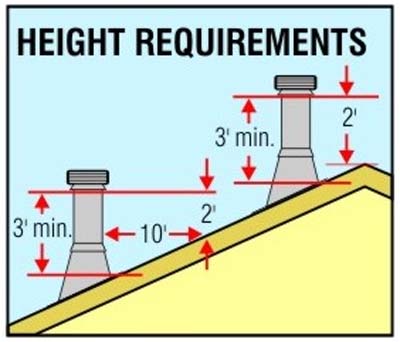
- Masonry chimneys must be at least three feet above the highest point of contact with the roof structure, this means they end three feet above any other part of the roof. Also, chimneys should extend a minimum of two feet higher than any part of the roof within ten feet horizontally. The same rule goes for adjoining buildings or tall trees that may be within ten feet of the chimney’s peak. The point here is that the end of the chimney should be high enough to avoid interference and pressure from wind hitting the roof or other building structures so that backdrafting does not occur. Your chimney sweep will recommend a chimney extension of your current flue if you are in violation of these codes. Alternatively, you could look at alternate heating sources for your home.
- 3. A
chimney that has
improper clearances such
as an unsafe heating
appliance attached to it
- NFPA 54, the National Fuel Gas Code, recommends that “when a new appliance is retrofitted into an existing installation, or an existing appliance is removed from a common vent, the entire venting system, which may include a masonry chimney, should conform to current codes.” All components of the new appliance must be properly installed and working for heating boilers, furnaces, and water heaters to work correctly along with your chimney. Additionally, venting too many appliances into a single flue may exceed its capacity and may be unsafe. Your chimney sweep will know the proper clearances and codes for heating appliances and be able to make recommendations on your system.
- 4. Missing
or open chimney cleanout
doors, any cracked
bricks, or holes in your
chimney
-
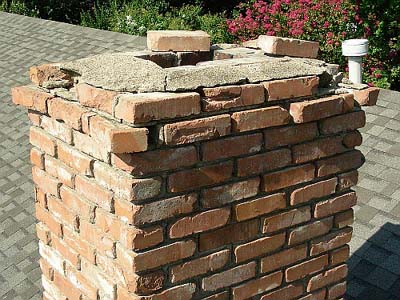
-
A missing chimney cleanout door or any other hole in the flue means that there is a fire safety hazard because sparks or ashes can fall out into your living area and catch on fire. Also, these issues make it impossible to maintain a draft in the flue so you may not even be able to get a fire started. If you open a chimney cleanout door or pull the flue vent connector from your flue and a piece of brick, masonry block, concrete, or flue tile liner scrap is there, it could mean there is damage to the interior of your chimney flue and pieces are falling to the ground. If you notice any of these issues then your chimney flue needs further inspection for safety today.
- 5.
Obstruction in the
chimney flue
-
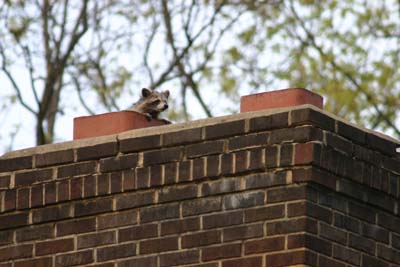
-
An obstruction in your flue such as a live animal(s), leaves, trash, bees, or abandoned nests are all likely if you do not have a chimney cap and have not used your fireplace recently. The obstruction will block the ability for the chimney to draft properly and will need to be removed prior to starting another fire. Please see our Obstruction Removal details for further instruction on how to handle your situation and call a professional chimney sweep to assess your problem.
- 6. Insufficient Combustion
- It is possible that the combustible material you are using is insufficient or poor quality, such as wet wood. It is also possible that the combustion air flow is blocked because the damper is missing or damaged, the intake is in a poor location that is not weather tight, or your hood and screen at the firebox are missing or damaged. A professional chimney sweep will check all of these things to make sure you have adequate combustion clearances and properly working parts that are not rusty, clogged, or broken. Once a fix is made, the airflow should correct itself eliminating drafting issues.
- 7. A missing chimney cap
-
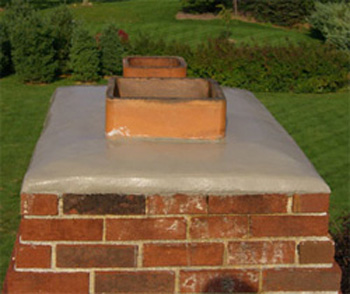
- A chimney cap is the first line of defense for your chimney. Its major function is to prevent debris, rain, and animals from falling into your chimney. A chimney cap is also responsible for protecting the chimney crown and chimney flue. Chimney caps are usually made of stainless steel or copper and both of these materials are known for their long life. An ideal chimney cap is rust resistant, corrosion resistant, water resistant, and it should withstand high temperatures and pressure differences. An ideal chimney draft is all about maximizing the inner hot air. The chimney cap has a crucial part in maintaining the temperature of the inner gas especially in windy cold regions, where wind will considerably cooler than the inside gas. A proper chimney cap design will create low pressure outside the chimney. Hence, the pressure difference will be maximized and thereby chimney drafting is increased. Another important role of the chimney cap is to increase the inner airflow. All exhaust gas and smoke should be expelled from the chimney. For the above reasons, most of the chimney caps are designed in such a way that the size of the chimney cap is larger than that of chimney flue. Any professional chimney sweep will recommend a chimney cap for these reasons as well as blocking obstructions from entering your chimney from the roof. If you do not have a cap today, it is time to call a sweep, figure out what type you need and install one today.
- How to eliminate smoke entering your living area when a fire is lite
-
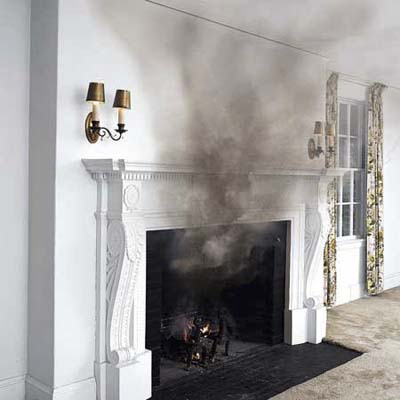
- Fireplaces are cozy places to relax in your home and it would be extremely frustrating if you got lots of smoke in your living room when trying to enjoy a fire. Not only would smoke entering your home ruin your evening, it could also be the sign of a greater health hazard from harmful gases entering your house. A careful investigation by a professional sweep is needed to find the exact cause behind the smoking problem. The first thing they will check is whether your chimney flue has a lot of soot or creosote buildup. Soot is produced due to incomplete combustion of organic material while creosote is produced by the combustion of wood. Ample amounts of soot or creosote can block the flow of smoke inside the flue and smoke has no other way out except to enter your living room. If this is the case, a simple annual cleaning by your chimney sweep will clean the chimney to avoid blockage. A chimney cap is also plays crucial part in your chimney that could help you in solving your smoke problem. During inspection, professional sweeps will make sure that chimney cap is in good condition and facilitates the airflow without a problem. Separating external air and wind from internal air is important and there are many varieties of caps that protect from vigorous wind. If your chimney cap is not in good condition, your professional sweep will fix it or recommend replacement. You can find more on this topic above.
- How to eliminate risk of Carbon Monoxide Poisoning
-
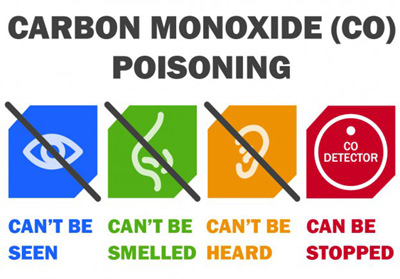
- Carbon monoxide (CO) is a colorless, odorless gas and you cannot find it directly, making it one of the deadliest risks associated with the chimney, gas flue appliances, and other gas heat sources. Approximately 500 people die of CO poisoning and around 5,000 are injured due to CO poisoning in the home each year. If you notice you are having a breathing problem, headache and nausea while you are using your heating appliance, you may be subjected to CO poisoning. If you suspect it, leave the house immediately and call the 911.
- For your own safety, every homeowner should follow these steps to prevent CO poisoning:
- • Install a CO alarm inside your home at a central location as well as outside every sleeping area.
- • Place CO alarms at least 15 feet away from every fuel-burning appliance to reduce the number of nuisance alarms.
- • Test your alarms every month and replace them according to manufacturer’s instructions.
- • Make sure your alarms can be heard, especially where individuals are sleeping, and make sure everyone in the family knows what to do if the alarm sounds.
- • Have all gas, oil or coal burning appliances inspected by a professional chimney sweep every year to ensure they are working correctly and are properly ventilated.
- • Never use a grill, generator, or camping stove inside your home, garage or near a window.
- If your CO alarm goes off, follow these simple steps:
- • Get everyone into fresh air immediately and call for help.
- • If anyone is experiencing symptoms, call 911 immediately for medical attention.
- • If no one is experiencing symptoms, call a qualified professional chimney sweep to investigate for possible CO buildup and any structural damage to your chimney.
- Sources and Prevention of Carbon Monoxide in your chimney
- CO buildup can occur if your chimney flue is blocked by any materials or animals. Back drafting is another major source of CO poisoning. Your chimney will work only if it absorbs combustible gas and expels exhaust gas outside your home. The backdraft could due to blockage of the chimney flue, insufficient combustible material and poor ventilation. Professional sweeps will assess the condition of the chimney and look for all of these signs. They will also ask the homeowners whether they have felt any of the symptoms of CO poisoning. They will ensure that the draft produced in the chimney is good enough to avoid any possible backdraft. Your professional sweep will inspect each part of the chimney system carefully for any possible corrosion, blockage, rust, or soot. If any defect is found, such as a missing damper, they would discuss it with you and recommend a fix immediately. They will also clean all parts of chimney to prevent any possible blockage due to the accumulation of creosote. They will assess the ventilation of the area around the chimney and may suggest a modification in the design if ventilation is poor. They may also suggest for you to use dry wood as your combustible material going forward. Once the proper fixes are made, you must install a CO detector in a central location as well as outside every sleeping area to avoid any risk and help you and your family sleep well at night knowing you are safe.
- How to get rid of bad odors from your fireplace
-
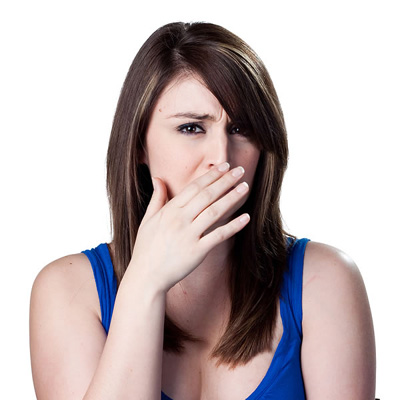
-
A backdraft, moisture inside the chimney, a dead animal or leaves, or creosote buildup are the main reasons you will have a bad odor coming from your chimney/fireplace. Your professional chimney sweep might suggest air tight dampers that prevent a backdraft from occurring when the chimney is not in use. They may also suggest to you switch to burning only dry wood that produces more heat with less temperature to avoid a backdraft, especially if you live in a windy area. If you have moisture in your chimney from rainwater, your professional sweep will suggest the installation of stainless steel based chimney cap to prevent rain water from entering and to prevent rusting. If an obstruction such as a dead animal or rotting leaves is causing the odor, your sweep will remove the obstruction and clean the flue. If it has been well over a year since you had your chimney swept, creosote buildup itself could be the bad odor, and it only gets stronger/worse in the summer. Hence, chimney flues should be inspected regularly to ensure cleanliness and proper functioning and avoid any foil odor buildup.
